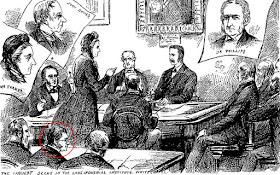One of Alvan Clark's most enthusiastic customers was Mr. Percival Lowell, whose mommy gave him a 2 1/4 inch Clark on his fifteenth birthday. Astronomy was the kind of hobby mother and son could share atop their Brookline mansion. At his father's insistence Percival went into business in Japan (above - the tall one without the hat). But he always returned to his first love; astronomy. And as the end of the 19th century approached, Percy was attracted by the approach of Mars.
The photographic proof was conclusive. What Percival had seen as canals proved, when seen through a newer, bigger, telescope, proved to be just an optical illusion, or maybe the blood vessels in the back of Percival's own eye. Percival had a nervous breakdown. And when he recovered he sought to re-establish his reputation. He took up the search for the the last great mystery in the night sky, the powerful conundrum of Planet X.
According to Percival's own mathematics, there was something very odd about the planets Neptune and Uranus. They were too big, their orbits were odd, Neptune was spinning on its side and they both wobbled. It looked to Percival as as if there had to be another planet further out from the sun, tugging at Uranus and Neptune. He called his suspect Planet X. Percival even calculated Planet X's mass, and he knew exactly where it had to be in the sky, 40 times further out from the sun than the earth.
For ten years Percival and his assistants – okay, mostly his assistants – scoured photographs of the night sky, searching for the tell-tale movement in the star field that would herald the discovery of Planet X. Twice the camera on Percival's 12” Clark took pictures of the moving X. But the humans who had to examine each one of the thousands of photographs, failed to notice the one dot that had moved slightly. And then, in 1916, at the age of sixty-one, Percival Lowell suffered a stroke and died. He was buried next to his beloved 12” Clark atop Mars Hill. But thanks to Percival's fortune, the search for Planet X continued.
In 1930 Clyde Tombaugh found Planet X. And since he was being paid by Percival's endowment, and still using Percival's 12” Clark, Planet X was named using Percival Lowell's initials – PLuto. And isn't it amazing that Planet X became the official IX planet in the solar system? You don't often get to use Roman Numerals in a joke.
Ah, but things were about to get even more amazing. With the refinement of observations of the outer planets a number of new great mysteries appeared in the night sky, as they always do. The more you know the less you know, you know. You know?
The first thing astronomers realized they did not know was why two of those three cold blobs of rock and ice circling far out from the Sun– Neptune and Uranus - were so darn massive, too massive to have been formed so far out at the edge of the spinning disc that eventually became the solar system. In 2005 the mystery was solved (we think) at the University of Nice, France. Neptune and Uranus, said the French astronomers, had actually formed in the inner solar system, and out of rock, like the Earth, Venus and Mars.
Four billion years ago the newly formed gas giants Jupiter and Saturn had turned the inner solar system into pool table on the break - with the still molten planets and asteroids slamming and careening into and off of each other. This gravitational pin ball game had pulled the moon into a collision with the Earth, and allowed its capture. It had ground up the rocks trying to form a planet into the asteroid belt. And it had flung Uranus and Neptune out of their formation orbits and into their current orbits, leaving behind a lot of oddities as they swerved out into the edge of our solar system.
And that left Pluto. The more people looked at the guardian of the outer realms the odder it looked. Better telescopes, including one in earth orbit, showed it to have less than two tenths of 1% of the mass of the Earth, and to be only about half the size of our moon. That was too small to have perturbed the orbits of Neptune or Uranus. In fact it was even too small to be classified as a planet.On August 24, 2006 the International Astronomical Union struck Pluto from the list of planets and gave it the new title of "134340 Pluto, dwarf planet". It seems that for all of Percival Lowell's careful calculations, and for all of Clyde Tombaugh's perseverance, and for all the power of Alvan Clark's thumb, finding Planet X right where it was supposed to be was...just a coincidence. It was the human mind which mistook blind luck for a deep cosmological insight, just as the swelling in the blood vessels behind Percival Lowell's eye had built the canals of Mars.
- 30 -



























































